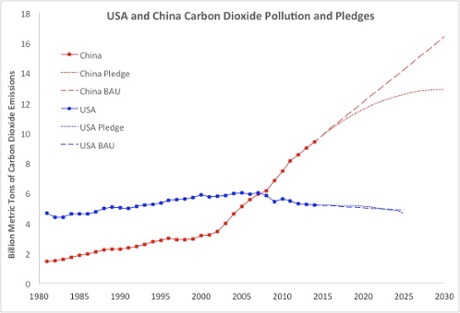China Will be Doing the Heavy Lifting Under the China-US Climate Change Pact
With key exceptions, Western media, governmental, and institutional/NGO responses to the “game-changing” agreement on climate change signed in Beijing at the APEC Summit between China and the US has generally been positive.
Yet, with some condescension, Time magazine remarked that “China had grown up” while the Atlantic Monthly sarcastically described China as an “overgrown teenager, large and powerful but clumsy and developing” who had finally come around, no longer being obstinate in rejecting caps on its CO2 emissions. Meanwhile, the Christian Science Monitor opined that China had finally accepted “universal values” as if China did not perceive the health of the planet as a common value of all human kind.
But, sarcasm and political rhetoric aside, among the most unfair criticisms were unsurprisingly uttered by US Republic House Majority Leader John Boehner and soon-to-be Senate Majority Leader Mitch McConnell. The latter blasted China as having pledged to “do nothing” regardless of China’s position as a much poorer developing country. A Guardian essay countered that if China was intent on maintaining business-as-usual and doing “nothing”, it would be hard pressed to meet its pledges.
Here’s what the two countries committed to: the US side will reduce greenhouse gases (GHG) by 26-28% below 2005 levels by 2025. The Obama Administration had previously consigned to reducing emissions by 17% by 2020. The US will also double emissions cuts of 1.2% per year from 2005-2020 to 2.3 to 2.8% from 2021 to 2025. To keep its promise, the US would submit the new reduction targets by the end of the first quarter in 2015 as its contribution to the UN Framework Convention on Climate Change treaty that will be finalized in Paris late next November.
For its part, China will target CO2 emissions to peak around 2030 or before as well as expand renewable energy sources to about 20% of total usage (from the current 8%) by the same year. This is in line with a 2011 Lawrence Berkeley National Laboratory study that predicted China’s CO2 emissions would peak around 2030 due to high carbon intensities involved in a number of sectors that China continues to invest substantially in. This pledge requires China to install up to 1,000 gigawatts of new sources of nuclear, hydro, wind and solar power.
The Guardian retorted, on the contrary, it is the US that will have a relatively easy time to meet its new commitments. US CO2 emissions are already 10-15% lower than in 2005 and falling by 1.5% a year. The new cuts will only require the US to continue on the current path, albeit a little faster. So, it is Senator McConnell who has vastly misrepresented the challenges facing each nation.
According to the Economist magazine, China has emitted more GHG than America since 2006 and by 2014-15 China’s total will be twice that of the US and coal burning remains by far the largest component of the country’s energy mix. Observed historically, however, the 10 biggest emitters from 1850 to 2007 were respectively the US (28.8%), China (9%), Russia (8%), Germany (6.9%), US (5.8%), Japan (2.8%), India (2.4%), Canada (2.2%), and Ukraine (2.2%). China’s per capita CO2 emissions were 5.83 t/capita in 2010 compared to 17.2 t/capita in 2009 for the US or roughly 1/3 of the US.
The tasks that lay ahead for China are daunting. In an interview with NPR, Roger Pielke, Jr., a professor of environmental studies at the University of Colorado, underscored, “That’s roughly the same as deploying one nuclear power plant of carbon-free energy every week starting today until 2030.”
A renewable energy plan devised by China’s National Energy Administration called for the boosting of hydropower to 290 gigawatts by next year that would average 6% growth since 2010. Wind power will top 100 gigawatts, marking 26% annual growth and solar power will rise to 21 gigawatts growing at 90% per year. As well, China has 22 nuclear power plants in operation and 26 being built/planned. In addition, China’s national nuclear corporation will team up with Canada’s Candu Energy to develop reactors that can use spent fuel from conventional reactors.
Reduction of coal use is imperative as 80% of China’s electricity is generated using the dirty fuel. Cited by AP, Alvin Lin, China climate and energy policy director with US-based National Resources Defense Council projects China will have to hit coal reduction targets at least 5 years ahead of 2030 to reach its target. The country also must introduce and enforce even tougher energy efficiency standards, milder versions of which have been implemented since the mid 2000s.
Going forward, China must overhaul its energy infrastructure to use more renewables and provide sufficient incentives for especially commercial and industrial consumers to switch to renewables and to conserve energy. Chinese banks and various levels of government are being called upon to facilitate more financing and provide tax breaks for energy users to install solar panels and other renewables equipment like in the US.
China will also need to build more efficient power plants and buildings along with better wind turbines and other clean energy equipment and infrastructure. The Xinhua News Agency reports the US and China are collaborating to build a major carbon capture and storage (CCS) facility on the Chinese mainland. In this respect, perhaps SaskPower’s flagship CCS facility at the Boundary Dam coal-fired power plant in Saskatchewan, the world’s first operational commercial scale CCS plant, could serve as a model.


0 Comments
Trackbacks/Pingbacks